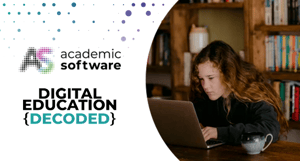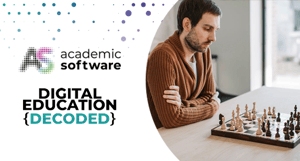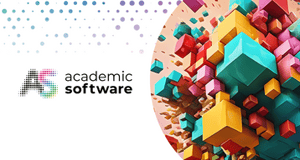interview cloud software solutions digital transformation digital tools
Education's digital transformation: interview with Pieter Barremaecker
The way digital resources are used in education has changed dramatically in the last few years. These trends were evident before the pandemic, but have accelerated as the world of education was thrust overnight into a greater emphasis on off-campus learning. Academic Software has been at the forefront of making sure students, teachers, lecturers and researchers can access the digital assets they need, wherever they are.
This week, Pieter Barremaecker, co-founder of Academic Software spoke with us about the impact of the digital transformation in education in the last few years.
The impact of the digital transformation in education
The last five years have seen big changes in the world of education ICT. Ten years ago, the only computers you had in education were the ones in labs and classrooms; the big computer labs where you had fixed PCs, where you could access the internet. People used to have to travel to the university to access the internet. Now, everybody has their own internet-connected device. And not just one device, people have more than one device. So the idea from the past that students or teachers are willing to go to the campus to use a certain software program has faded away. Covid accelerated this trend, for sure.
This trend of seeing on-site computer labs replaced by Cloud resources and own devices is great for institutions because the space they used to use for computer labs and servers is freed-up. It is great for students and teachers because learning is more flexible, it can happen away from campus. But of course it changes the way software and other digital assets are managed. Every school dreams to say just bring your own device because then you can do education at home. But they often struggle to make this organised and structured. ICT staff can’t go around installing new software on everyone’s individual device. The server room is no longer in the school or university but in some other data centre on the other side of the world. That means that the ICT management totally changes.
Managing school and university computers in the cloud era
ICT infrastructure used to be all on premises. They had server rooms where they had guys with screwdrivers fixing everything and installing everything. Cloud means that that server room is no longer in the university but in some other data centre belonging to Microsoft or Amazon. You now have a position where ICT people maintain dashboards. It is no longer about going physically to that server to fix something or upgrade something; the Cloud infrastructure takes away a lot of those tasks and you don’t have to do it yourself.
One significant challenge with the Cloud is that it’s sometimes seen by users as a kind of free, common resource. But Cloud servers are real, electricity costs are real, and access costs real money, and so it’s important that you can monitor and control the costs of Cloud access. It is scary to think that a researcher may get a budget to run a big calculation on an external server, and goes ahead and does it, but then forgets to stop the machine, and no one notices until 45 days later when the invoice arrives.
At Academic Software we use a credit system that limits expenditure to what you want to set. Students and teachers can share credits for Cloud tools, virtual machines, and desktops in a measurable way. So ICT coordinators and managers get a clear overview in a customized management portal, and can monitor expenditure according to each class or project group or budget line. And we can do the real-time cost calculations and limit spending to say 20 euros per student, or a set budget for a researcher, and we will automatically see if the machine is abandoned and shut it down to make sure that the costs are limited. IT departments don’t have to be scared that users will do something wrong and run up huge costs.
Another issue is making sure that you don’t under- or over-estimate the volume of Cloud resources you need. Go under and users get frustrated because there’s not enough capacity when they need it and things don’t work. Or go over, and your budget people are unhappy because you’re paying for resources that aren’t being used. This is always the problem that institutions have: at three o’clock in the morning nobody uses it, and at five o’clock in the evening, everybody wants to use it and everybody complains that there are no resources. That’s why we made Academic Software to be flexible – you can automatically scale up and scale down those resources as you need them so you don’t have to pay for capacity 24/7 that you’re not using, but you do have the capacity when you need it.
Empowering educators with tailored digital tools
Another big change is how software and digital resources have become part of every single educational syllabus. Ten, even five years ago, using software at schools and universities was something niche. Maybe if you did Psychology, you used SPSS once for a research project. And if you did something with languages, you probably didn’t use software or online tools. Nowadays everything is software – if you’re a translator, you have to learn to work with translation software; if you are a nurse, you have to learn to work with that software; if you do dietary courses, you have to learn to work with dietary software. So it’s not like ICT is only for those courses like computer science; it’s for all courses, more and more everything gets a touch of ICT. And that new group of users is a group of users that are non-core users, they’re not there to learn how to install software and deal with technical issues, they just want to click the button and it has to work.
Streamlining software usage for teachers and lecturers
A good thing is that teachers and lecturers can ensure their students get software and digital assets that are more tailored to their exact needs. In the past, everyone at an educational institution got the same software, the same applications. But what we try to do now is make sure people can make individual choices about software or other digital tools.
But, challenges with managing software and digital assets have meant that for many teachers and lecturers, using software for teaching has been a kind of stress point. For example, if you want to do something around mindmapping, if you’re a lecturer and you say, “Let’s design something. Mindmap it by next week… We can all use this tool. You can download it here.” That lecturer will probably only do that once because if they have 100 students, he or she will get 15 questions from students about downloading and installing the software. That lecturer is there for the teaching, they’re not there for IT support. So next year they’ll say, “I won’t do this again. I will just show you a series of slides, because slides always work.” The goal of Academic Software is that we guarantee that if a teacher says you have to use this tool, that it will work, and if it doesn’t work, the student can call us and leave the teacher to focus on teaching!


